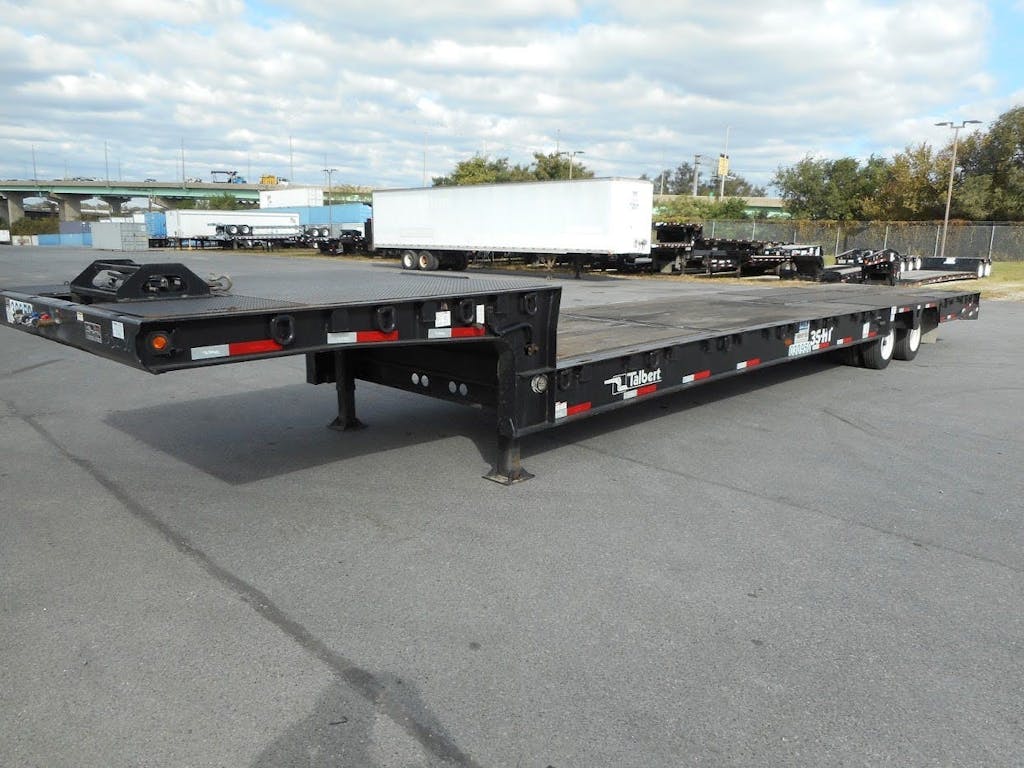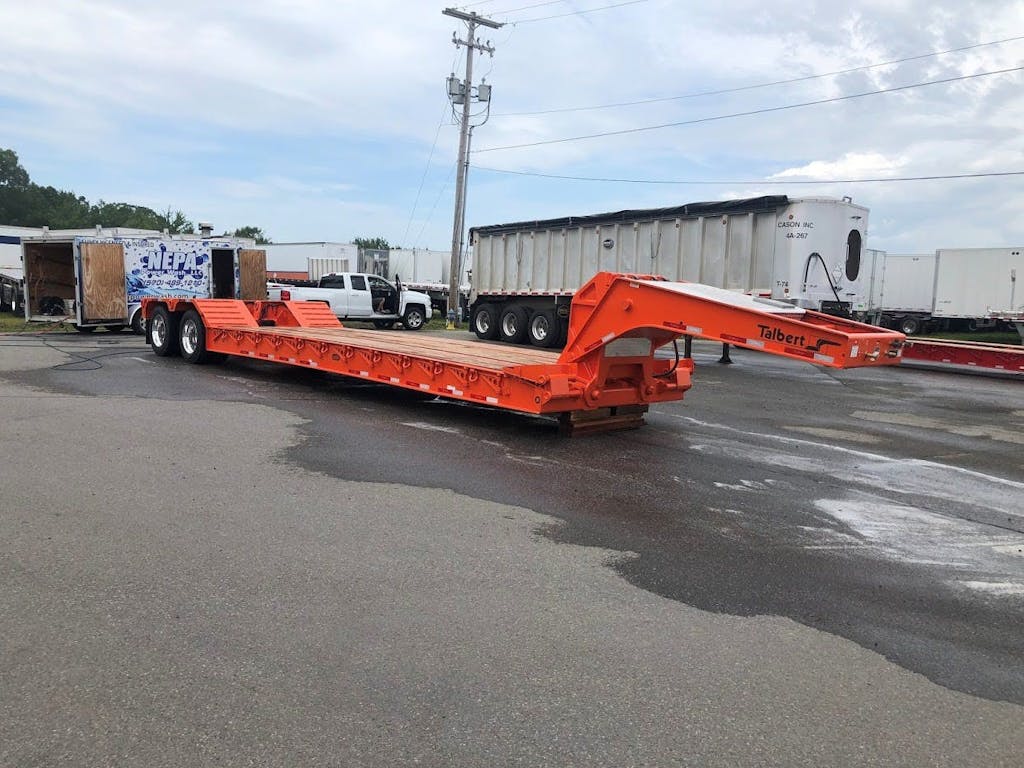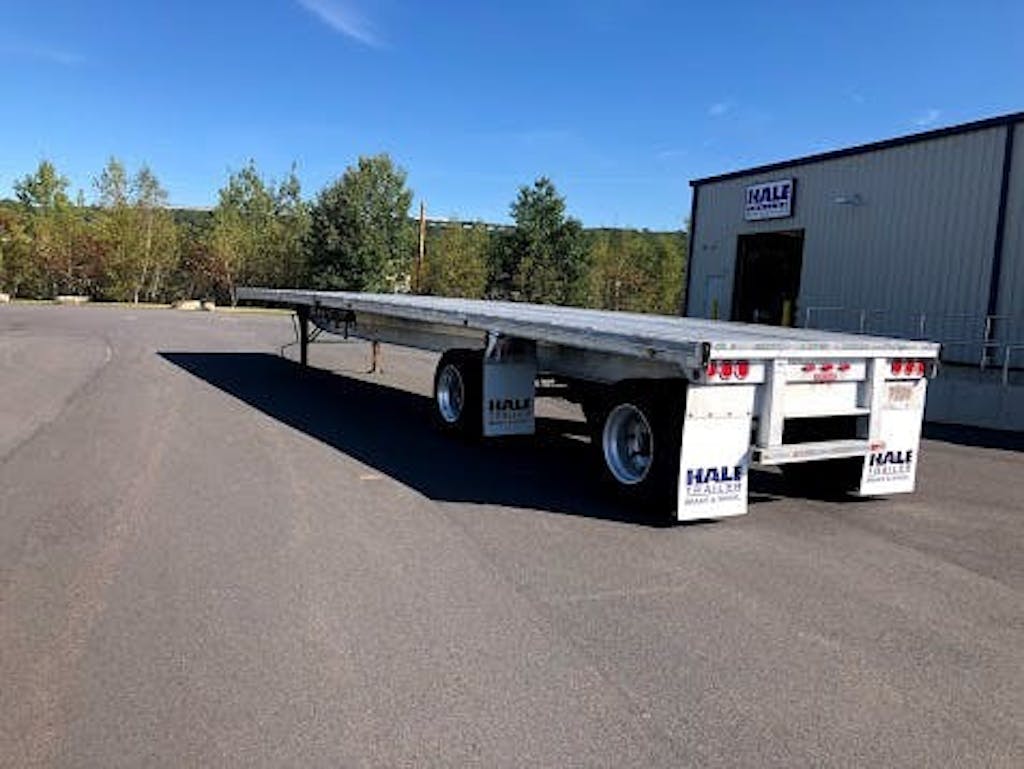Step Deck vs. Flatbed Trailer: What Are the Differences?
November 25th, 2019
If you’re considering a new or used drop deck trailer, step deck, or a flatbed trailer, how do you know which is the best choice? Many drivers and operators face challenges when it comes to hauling larger cargo, especially that which requires permits. Knowing the differences can save time, money, and hassle in the purchase process.
When it comes to the major differences in step deck trailers vs. flatbeds, height capabilities separate the two the most. If you plan to rent or purchase a trailer for hauling large loads, read on to make sure you choose the right trailer for your needs.
What is a Step Deck Trailer?

A step deck trailer, also known as a drop deck or lowboy trailer, is a commercial trailer designed to carry tall cargo that exceeds the legal height limit if transported on a traditional flatbed trailer. Transporting tall cargo on a step deck prevents drivers and operators from having to obtain permits.
Step deck trailers have two decks, an upper and a lower. Many step deck trailers also have ramp capabilities, making it easier to load and unload equipment. Their lower height allows forklifts to easily access cargo since they’re closer to the ground. Options can be fixed-neck, gooseneck, and removable gooseneck (RGN), depending on the type of freight and loading/unloading needs. Fixed-neck trailers have more limited options for loading and unloading, while RGNs can be loaded on either the front or back. This isn’t even to mention schnable trailers which lift a load from each end.
Common Freight Carried on Step Deck Trailer
Heavy freight and machinery are commonly transported on step deck trailers due to their larger size. Each state has different laws regarding cargo size, but generally, the maximum height is 13’ 6” to 14’, even with a permit. This is especially important to ensure the safety of the driver and clearance for bridges.
The following is a list of the most common freight transported on a step deck trailer:
- Tractors
- Excavators
- Building Materials
- Agricultural Materials
- Machinery
Double Drop Deck Trailers

For extra-large, heavy loads, double drop deck trailers are used. They get their name from the two higher decks – one in front, one in back – that bookend a lower deck. The lower deck is commonly referred to as a “well.”
They can carry taller and heavier loads due to their option to have 2 or more axles. Double drop decks have a flip axle that can be laid on the deck when not used or flipped down when hauling extra weight.
Federal regulations specify that trailers maintain a certain number of axles dependent on the weight of freight. Using a drop deck trailer with extra axles helps drivers and operators in hauling heavy freight without extra permits. If you’re trying to decide between a step deck vs. flatbed trailer, you’ll want to consider the height as well as the weight.
What is a Flatbed Trailer?

Flatbeds are a great, essential trailer without sides or a roof, commonly used for standard size loads. When carrying heavier freight, many flatbeds have the option of adding additional axles to meet federal weight guidelines. Technically speaking, drop deck and step deck trailers are flatbeds with the addition of extra decks.
Flatbed trailers can be made of aluminum, steel, and composite, and have options for additions like curtain-sided walls, extendable decks, and multilevel decks (drop deck). They have a standard deck height of 5 feet and can carry loads up to 8’ 6” tall.
What Types of Freight Do Flatbeds Carry?
Flatbeds are a great trailer option for carrying a variety of freight, especially larger quantities of heavier items. They are not well-suited for taller cargo and have limited loading and unloading capabilities.
Common types of freight carried on a flatbed trailer are:
- Raw materials
- Construction supplies and equipment
- Lumber
- Heating and cooling units
- Formed concrete
- Vehicles
Step deck Trailer vs. Flatbed Trailer: Which Should You Choose?
The biggest question to ask when considering a step deck vs. flatbed trailer is what type of freight you’ll be hauling. If you know that freight will typically be shorter, a traditional flatbed trailer will serve your needs. If your freight exceeds 8’ 6” tall, a step deck trailer will serve you needs best.
The following list shows general, overall legal load dimensions for commercial trailers, including step deck and flat bed. Since each state maintains different legal limits, it’s important to check with local authorities to ensure compliance.
Legal trailer dimensions with freight:
- Length = 48 to 53 feet
- Width = 8 feet 6 inches
- Height = 13 feet 6 inches
- Weight = 80,000 lbs.
With legal dimensions in mind, here are factors to consider when choosing between a step deck trailer or flatbed:
- A typical flatbed trailer is 5 feet above the ground, meaning freight cannot exceed 8 feet 6 inches in height.
- Step deck trailers typically have a lower deck height of 3 feet 6 inches, meaning freight cannot exceed 10 feet in height.
- Step deck trailers generally have an 11-foot-long upper deck, and 37-foot-long lower deck (equaling general legal max length of 48 feet).
- Step deck trailers generally weigh more than flatbed trailers, meaning freight weight needs to be closely considered so it doesn’t exceed the 80,000-pound limit.
- Double drop deck trailers’ lowest deck is 22 inches, meaning freight height cannot exceed 11 feet 8 inches.
Whether you need a step deck or a flatbed trailer, Hale Trailer Brake and Wheel, Inc. has 12 trailer rental locations, each with knowledgeable representatives prepared to serve you. Our wide variety of drop deck trailers for sale and rent, as well as our extensive inventory of commercial trailers and service offerings, makes us the go-to source for all your trailer needs.
All the information on this website – https://www.haletrailer.com – is published in good faith and for general information purposes only. Hale Trailer Brake and Wheel does not make any warranties about the completeness, reliability and accuracy of this information. Any action you take upon the information you find on this website, is strictly at your own risk. Hale Trailer Brake and Wheel will not be liable for any losses and/or damages in connection with the use of our website.
